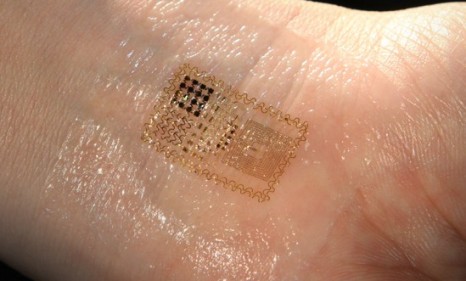Band-Aid... or computer?
A new technology places computer circuitry into a flexible skin patch the size and thickness of a postage stamp

Imagine a computer thinner than a piece of tape. That might seem far-fetched, but engineers from the University of Illinois have created a form of electronics that's so thin and flexible it can be worn like a Band-Aid. Once it hits the marketplace — and it's not clear yet when that might be — this innovation could be used for everything from music to medicine. "It's a technology that blurs the distinction between electronics and biology," says developer John Rogers, as quoted by BBC News. Here, a brief guide:
How does this new device work?
These "epidermal electronics" use a simple network of silicon-based computer circuitry that's manufactured in a micro-thin membrane. The circuits are then integrated onto elastic, transparent sheets the size and thickness of a postage stamp; these attach to the skin without the need for adhesive. Putting them on is as easy as applying a temporary tattoo: Just place one on your skin, rub the sheet with water, and you're done.
The Week
Escape your echo chamber. Get the facts behind the news, plus analysis from multiple perspectives.

Sign up for The Week's Free Newsletters
From our morning news briefing to a weekly Good News Newsletter, get the best of The Week delivered directly to your inbox.
From our morning news briefing to a weekly Good News Newsletter, get the best of The Week delivered directly to your inbox.
What uses could this have?
The range of applications is virtually unlimited, especially for health care. Placed on the forearm or chest, they could measure heart rate and other vital statistics. Placed on the neck, they are sensitive enough to pick up throat muscle contractions, so they could help people with speech problems. They could also be used in neonatal care to monitor the health of premature or sick babies. They could even form the basis of a "smart" Band-Aid that would speed wound healing by electrical stimulation.
What about for entertainment?
It's possible that these circuits could be used to accommodate music players, wi-fi components, or even cell phones that you wear on your skin. The opportunities for gaming, too, are countless, especially since electronic patches can be programmed to respond to subtle body movements or voice commands.
A free daily email with the biggest news stories of the day – and the best features from TheWeek.com
Sources: BBC, Discovery, International Business Times, Science
-
 What role will Trump play in the battle over Warner Bros. Discovery?
What role will Trump play in the battle over Warner Bros. Discovery?Today’s Big Question Netflix, Paramount battle for the president’s approval
-
 ‘The menu’s other highlights smack of the surreal’
‘The menu’s other highlights smack of the surreal’Instant Opinion Opinion, comment and editorials of the day
-
 Education: More Americans say college isn’t worth it
Education: More Americans say college isn’t worth itfeature College is costly and job prospects are vanishing